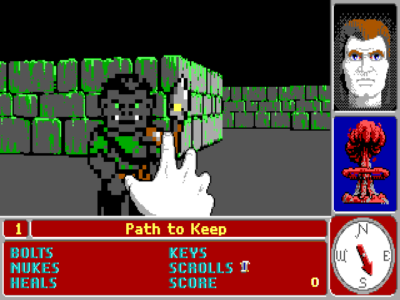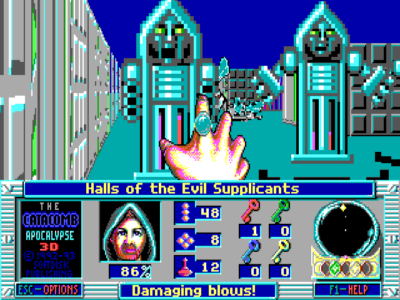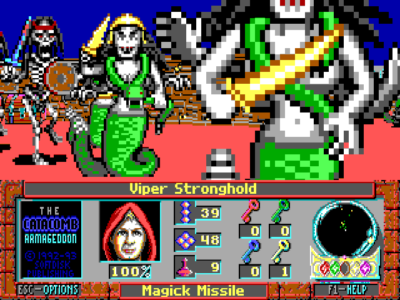
Catacomb 3D Series
Written by: Stoo
Date posted: March 4, 2014
- Genre: Action
- Developed by: id software \ Softdisk Publishing
- Published by: Softdisk Publishing
- Year released: 1991
- Our score: 3
Greetings, retronauts. Today we’re taking a trip back through time, to the earliest days of first person shooters. Our journey will take us to a time far before the proliferation of real-war shooters, before Far Cry, before anything from Valve. As we pass into the 90s check your PC – it’s gone beige! Your monitor has probably transformed from that big flatscreen into a 15″ CRT. Mouselook shooter controls as we know them disappear, and you’re now using arrow keys on one hand and ctrl, alt and space on the other.
We should take a few brief stops to get our bearings, and a logical choice of waypoints would be major releases from iD software, milestones in the development of the FPS. So the first year we visit is 1996. Quake, that game of nailguns and ogres, is a current champion of the genre. It declares to the world that shooters are truly 3D now, both in terms of level geometry and character models. We of course must go further back than this, into the pseudo-3D elder days.
We arrive in a vortex of swirly VGA effects in 1994… and we stand knee deep in slaughtered monsters and demons. Curious, is that a spongy-sounding midi tribute to Slayer that I hear? This must be Doom! The early titan has, along with intense hellfiend-slaughtering action, some new features such as network multiplayer and a world with a vertical axis. An enormously influential game, it sets a path for the genre to follow. Indeed, you don’t even hear the term “first person shooter” much here; the pretenders that spring up in the wake of iD’s classic are re collectively referred to as Doom Clones.
From here we go to an even more remote era; the primordial days of 1992. It’s a strange world indeed; every level is totally is flat. The walls are at 90 degrees to each other. The floors and ceilings are untextured expanses. The brightness of the lighting is totally uniform within every map. It’s Wolfenstein 3D, and you were probably expecting us to visit here. You might even think of it as the first game of its type.
Yet for our destination we must go even further back, one more year into the primordial mists of time, to the Precambrian era of shooters. Even as ancient specimen as Wolf3d has its own antediluvian ancestor. So the true goal of our quest through time is id’s previous work: Catacomb 3D.

I am actually about to shoot this orc with a fireball, not just poke him in the face.
Pretentiously written twaddle aside (it’s an indulgence of the 30-something to regard themselves as old, and their childhood as some distant epoch), I thought it would be interesting to go right back to one of the earliest examples of a game that’s recognisable to us today as a first person shooter. For the purposes of this document we can also cast our eye over the follow-up trilogy of Catacomb Abyss, Armageddon and Apocalypse. These were done in-house by publisher Softdisk after id moved over to the Apogee stable. The interface is spruced up and a bunch of textures and enemies are added, but really you can take all four titles as chapters of the same larger game.
(edit jus to keep the record-keeping straight, the Abyss series was actually released after Wolf3D).
Like Wolf3D, these games are powered by a raycasting engine. As I understand it this generates a 3D view by shooting out a ray from your position for each column of pixels on screen, finding out where that hits a wall and drawing a slice of it accordingly. It was, at the time, a great way to create smooth-scrolling interior environments that could run at a decent speed on a home PC.
If we’d taken our retro-gaming time machine all the way back to iD’s first use of raycasting, indeed their earliest first-person shooter, we would have gone one step past Catacomb and arrived at the rather obscure Hovertank 3D. Catacomb’s big improvement was adding textures to the walls – a pattern of wood or stonework – as opposed to Hovertank’s planes of flat colour. The biggest difference between Catacomb and Wolf3D then is simply colour range – Catacomb uses the older EGA graphics which means only 16 colours can be on screen simultaneously, as opposed to Wolf3D’s 256.
So then each level is basically a dungeon-like layout. Across the games though there is quite a range of themes and colour schemes, which is a small plus if you’re a bit bored of modern shooters existing in a world of brown and grey. 3D and Abyss and Armageddon have various takes on fantasy themes so you have dank stone chambers, mysterious temples, overgrown gardens and firey infernos. Apocalypse meanwhile goes all scifi with metal panelling and neon green; it’s a bit surreal actually.
You are cast in the role of some sort of wizard, and so your weapons are fireball spells (there are no examples of hitscan, ie zero travel-time, weapons). In fact you only have three or four attacks – starting with an infinite supply of regular fireballs. Catacomb 3D lets you hold down fire for a stronger blast, which Abyss seems to have abandoned. Then there’s a rapid burst of ten-ish shots, and a final spell that fires out a ring of eight powerful shots to try and hit enemies in all directions. These each have their own trigger keys, rather than selecting one for your main trigger with number keys. Finally health potions are not instant-effect but stored for use when you choose.
At first glance, it all seems rather easy. Early enemies have only spears or claws, So you can just laughingly pummel them with fire from 30 feet away. However, what makes them rather more devious is their silence, until actually attacking you. id hadn’t yet thought to include “I’m idling here waiting to be triggered” noises or an “I am alerted and about to attack” shout. This can prove tricky given some enemies are initially hidden, or basically inanimate and indestructible until you reach a certain point and trigger them. To help with your awareness, you have a kind of radar screen that shows relative enemy location, although for each type you need to find a corresponding gem before they show up (and hidden enemies don’t show until activated).

Apocalypse throws a bunch of goofy looking robots at you,
Also, your turning rate is pretty slow. It’s a bit like Robocop stomping around to a new heading whilst forced to hold his gun straight ahead. In fact I recorded times to spin 360 degrees, because god knows I have nothing better to do with my evening. Doom: 3 seconds. Wolfenstein: 4 seconds. Catacomb: 5 seconds. In those later games you could of course hold down shift to speed turning, but Catacomb 3D running doesn’t affect turn speed.
So your danger is getting stabbed in the kidneys by orks, and responding too slowly when you try to whirl on the spot. The Abyss trilogy does add a faster turning option, although you have to hold down tab or v instead of shift, and the latter is precariously right next to C, used for healing potions.
Fortunately most “surprise attack” enemies didn’t seem too tough. Later foes are more durable – the Demons in particular are fireball-sponges. You also start to encounter monsters with ranged attacks. Abyss is fairly light on such things, just a few spooky floating mages. However Apocalypse with its scifi trappings is full of robots, little green mage things and and what I think are mechanical ants. All of which shoot various fireballs at you, making that instalment the hardest of the lot. Which I suppose is for a reason; these games do become very samey after a while so some added challenge is one way to shake it all up a bit.
The way forward seems to be taking things slowly, rather than dashing around with abandon. Advance cautiously, waiting to see if any zombies crawl out of the ground. Then let rip with a well placed barrage. One feature of gameplay I wasn’t expecting, is that spell and health pickups are destroyed if you shoot them. So you have to place shots carefully; I often found myself leading enemies back into corridors both to control their flow towards me, but also so I could give them a good volley without trashing all the loot they were guarding.
Also, try not to get lost as there’s no map. Which isn’t common for modern corridor shooters either, although they’re often so linear you don’t need one. Around the Doom generation, though, an automatically updating map was a common feature. Wolf3D lacked a map too, and I think during these early days the developers saw the act of navigating a maze-like environment as being itself a part of the challenge.
What you won’t see a lot of, oddly enough, is doors. Certainly not any animated ones. There are a few that simply disappear when triggered, and also they sometimes mark the end of level. However the game makes greater use of destroyable wall sections. You soon learn how to look for these – they’re often marked with a different texture such as a window or tapestry. Also you may as well just shoot the hell out of the end wall of every dead-end corridor, just to see if anything is there. The game does have keys, and finding them is pretty much your main purpose on every level.
On the audio side, effects are adlib-card squawks and chirps. Fairly sparse, but, the sort of sound that always gets me a bit nostalgic. As for music, the Abyss trilogy disappointingly seems to have none. 3D itself does have a soundtrack, by which I mean, one piece of music. Repeatedly endlessly. And it’s only like eight seconds long. So that’s actually kind of tortuous. (also, trivia fans, it’s copied over from Commander Keen 4. Along with a lot of the interface, now I think about it.) Here’s a top tip: fire up Winamp in the background, loaded with 90s apogee game soundtracks!

This could be a problem. Use the all-directions-explodey spell.
There’s not a lot more to say. As you might expect for this early a shooter the template is just find keys, shoot lots of monsters, make your way to a level exit. Your ultimate goal in each game is to defeat the evil Nemesis. Who looks a bit like a mix between Skeletor and Ghost Rider. I think in each game you’re a different wizard sent to kill him – they have that signature early-iD trick of a portrait in the interface to visually show your health, and it’s a bit different each time.
So honestly after a while, playing through these became a bit of a slog, and Abyss is the only one I finished. However, it was interesting to see how Catacomb fits into gaming history. All those shooters we enjoy today count this as one of their direct ancestors. Walking around mazes shooting at chunky sprites, we were exploring the foundations of what would become one of the most important genres of computer game. We might have been kind of impressed, but we had no idea what marvels were to come. It’s amazing to think just how much progress happened in the next ten years; Half-Life feels light years ahead of this.
Anyway, Catacomb 3D has come to be nearly forgotten in favour of its Nazi-shooting successor. I reckon that, even if it’s something you’d have to be a really serious retro-gamer to play for more than 15 minutes, it’s worth our raising a drink to this ancient ancestor of the shooters we enjoy today.


 Posts
Posts
Inspired by your fine retrospect, I decided to give this vaue childhood memory of mine a try again… I didn’t manage the more than 15 minutes barrier (it was a close call though), so I guess I am not a really serious retro-gamer. Mainly I hated the ultra-slow turning speed and destroying goodies by shooting at them.
But, as stupid as it might sound, the graphics look really great! Fun to look at and somehow like that cell shading games that try so hard what this game accomplishes with a lot less proccesssing power.
Btw: The “all-directions-explodey” spell (with exactly that name) should be in any future edition of D&D and such. 😉
March 8, 2014 @ 9:52 pm
Even if primitive, it is quite vibrantly colourful.
March 9, 2014 @ 12:38 am
Looking back, giving this such a low score seems utterly pointless. I think it’s still fair to say that there’s not a lot of incentive to play more than a handful of levels. Yet a score of 3 implies either it was a huge failure, which ain’t the case, or we’re penalising it just for being primitive, which seems the wrong attitude for a site like this in the first place.
Maybe the problem is, being such an early shooter, there’s not much we can compare it with. Whereas if we were to review a platform game from teh same year, we’re looking at an already mature genre with plenty of competent peers. So it’s easier to assess fairly and say what it ges right, and what should have been done differently.
I guess if I was writing this today I’d give it a … 5 or 6? Which I’m still not happy with but at least allows for some enjoyment for devotees of the shareware scene.
June 23, 2023 @ 9:16 pm